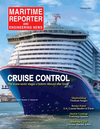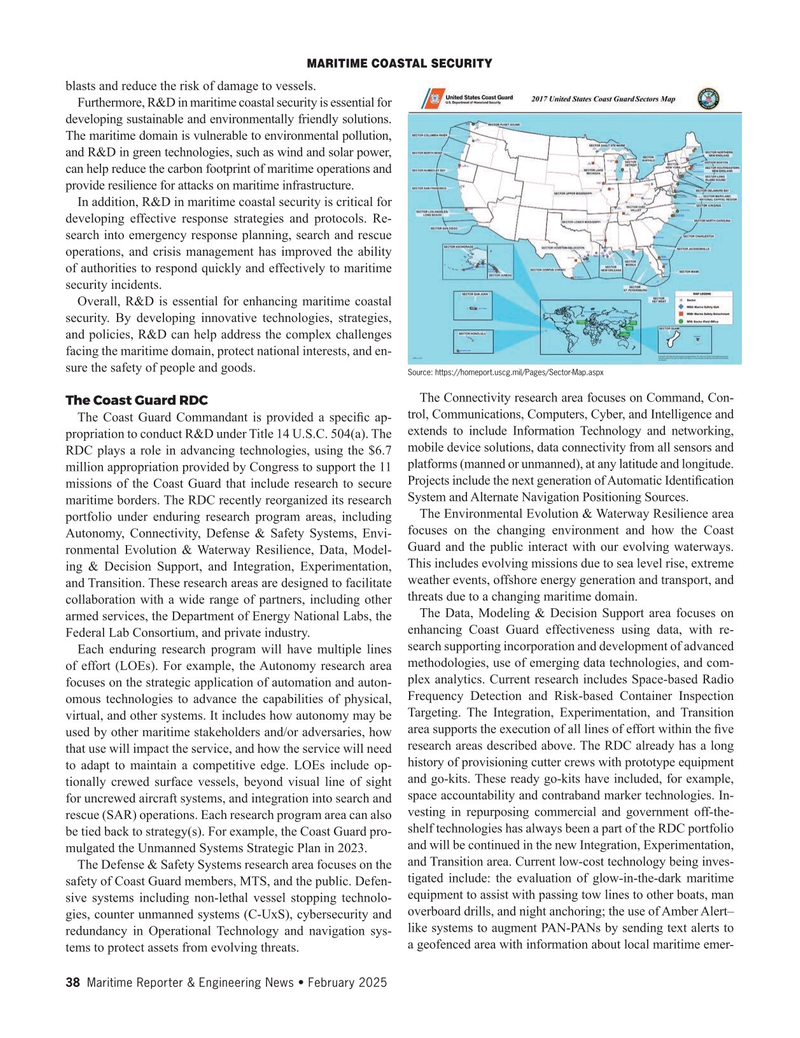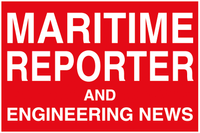
Page 38: of Maritime Reporter Magazine (February 2025)
Read this page in Pdf, Flash or Html5 edition of February 2025 Maritime Reporter Magazine
MARITIME COASTAL SECURITY blasts and reduce the risk of damage to vessels.
Furthermore, R&D in maritime coastal security is essential for developing sustainable and environmentally friendly solutions.
The maritime domain is vulnerable to environmental pollution, and R&D in green technologies, such as wind and solar power, can help reduce the carbon footprint of maritime operations and provide resilience for attacks on maritime infrastructure.
In addition, R&D in maritime coastal security is critical for developing effective response strategies and protocols. Re- search into emergency response planning, search and rescue operations, and crisis management has improved the ability of authorities to respond quickly and effectively to maritime security incidents.
Overall, R&D is essential for enhancing maritime coastal security. By developing innovative technologies, strategies, and policies, R&D can help address the complex challenges facing the maritime domain, protect national interests, and en- sure the safety of people and goods.
Source: https://homeport.uscg.mil/Pages/Sector-Map.aspx
The Connectivity research area focuses on Command, Con-
The Coast Guard RDC trol, Communications, Computers, Cyber, and Intelligence and
The Coast Guard Commandant is provided a speci? c ap- extends to include Information Technology and networking, propriation to conduct R&D under Title 14 U.S.C. 504(a). The
RDC plays a role in advancing technologies, using the $6.7 mobile device solutions, data connectivity from all sensors and million appropriation provided by Congress to support the 11 platforms (manned or unmanned), at any latitude and longitude. missions of the Coast Guard that include research to secure Projects include the next generation of Automatic Identi? cation maritime borders. The RDC recently reorganized its research System and Alternate Navigation Positioning Sources.
The Environmental Evolution & Waterway Resilience area portfolio under enduring research program areas, including focuses on the changing environment and how the Coast
Autonomy, Connectivity, Defense & Safety Systems, Envi-
Guard and the public interact with our evolving waterways. ronmental Evolution & Waterway Resilience, Data, Model- ing & Decision Support, and Integration, Experimentation, This includes evolving missions due to sea level rise, extreme and Transition. These research areas are designed to facilitate weather events, offshore energy generation and transport, and collaboration with a wide range of partners, including other threats due to a changing maritime domain.
The Data, Modeling & Decision Support area focuses on armed services, the Department of Energy National Labs, the enhancing Coast Guard effectiveness using data, with re-
Federal Lab Consortium, and private industry.
Each enduring research program will have multiple lines search supporting incorporation and development of advanced of effort (LOEs). For example, the Autonomy research area methodologies, use of emerging data technologies, and com- plex analytics. Current research includes Space-based Radio focuses on the strategic application of automation and auton- omous technologies to advance the capabilities of physical, Frequency Detection and Risk-based Container Inspection virtual, and other systems. It includes how autonomy may be Targeting. The Integration, Experimentation, and Transition used by other maritime stakeholders and/or adversaries, how area supports the execution of all lines of effort within the ? ve that use will impact the service, and how the service will need research areas described above. The RDC already has a long history of provisioning cutter crews with prototype equipment to adapt to maintain a competitive edge. LOEs include op- tionally crewed surface vessels, beyond visual line of sight and go-kits. These ready go-kits have included, for example, for uncrewed aircraft systems, and integration into search and space accountability and contraband marker technologies. In- vesting in repurposing commercial and government off-the- rescue (SAR) operations. Each research program area can also shelf technologies has always been a part of the RDC portfolio be tied back to strategy(s). For example, the Coast Guard pro- and will be continued in the new Integration, Experimentation, mulgated the Unmanned Systems Strategic Plan in 2023.
and Transition area. Current low-cost technology being inves-
The Defense & Safety Systems research area focuses on the tigated include: the evaluation of glow-in-the-dark maritime safety of Coast Guard members, MTS, and the public. Defen- equipment to assist with passing tow lines to other boats, man sive systems including non-lethal vessel stopping technolo- gies, counter unmanned systems (C-UxS), cybersecurity and overboard drills, and night anchoring; the use of Amber Alert– like systems to augment PAN-PANs by sending text alerts to redundancy in Operational Technology and navigation sys- a geofenced area with information about local maritime emer- tems to protect assets from evolving threats.
38 Maritime Reporter & Engineering News • February 2025
MR #2 (34-45).indd 38 1/28/2025 9:13:08 AM

 37
37

 39
39
